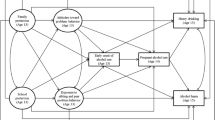Abstract
This study examined the dynamic relations between adolescent problem behaviors (alcohol, marijuana, deviance, academic failure) over time and predictors of these behaviors. Data from the National Youth Survey (1) included 1,044 adolescents (53.5% male; mean age at year 1=13.20). Dependent measures were adolescent alcohol use, marijuana use, deviance, and academic failure, assessed annually over 4 years. Independent measures included age, gender, marital status, income, family time, family support, time with friends, friend deviance, knowledge of friends, activities, and neighborhood problems. An associative latent growth modeling (LGM) analysis showed significant increases and relations between the four behaviors in both initial status and development. Second-order multivariate LGM analyses indicated that the four behaviors could be modeled by a higher-order problem behavior construct. Significant effects on the common problem behavior intercept or slope included time with friends, deviant friends, age, marital status, family time, and support. Additional effects were found to be specific to the initial status and slopes of individual problem behaviors. Overall, results indicate the importance of assessing the relations between adolescent problem behaviors as they change over time and identifying the risk and protective factors that have both common and individual influences on these behaviors.
Similar content being viewed by others
References
Elliott DS: National Youth Survey [United States]: Wave I, 1976 [Computer file]. ICPSR version. Boulder, CO: University of Colorado, Behavioral Research Institute [producer], 1997; Ann Arbor, MI: Inter-university Consortium for Political and Social Research [distributor], 1994.
Jessor R, Jessor SL:Problem Behavior and Psychosocial Development. New York: Academic Press, 1977.
Hops H, Tildesley E, Lichtenstein E, Ary D, Sherman L: Parent-adolescent problem-solving interations and drug use.American Journal of Drug and Alcohol Abuse. 1990,16: 239–258.
Newcomb MD, Bentler PM: Impact of adolescent drug use and social support on problems of young adults: A longitudinal study.Journal of Abnormal Psychology. 1988,97: 64–75.
Biglan A, Metzler CW, Wirt R, et al: Social and behavioral factors associated with high-risk sexual behavior among adolescents.Journal of Behavioral Medicine. 1990,13: 245–261.
Donovan JE, Jessor R: Structure of problem behavior in adolescence and young adulthood.Journal of Consulting and Clinical Psychology. 1985,53: 890–904.
Farrell AD, Danish SJ, Howard CW: Relationship between drug use and other problem behaviors in urban adolescents.Journal of Consulting and Clinical Psychology. 1992,60: 705–712.
Hawkins J, Catalano R, Miller J: Risk and protective factors for alcohol and other drug problems in adolescence and early adulthood: Implications for substance abuse prevention.Psychological Bulletin. 1992,112: 64–105.
Conger RD: The social context of substance abuse: A developmental perspective. In Robertson EB, Sloboda Z, Boyd GM, Beatty L, Kozel NJ (eds),Rural Substance Abuse: State of Knowledge and Issues.NIDA Research Monograph 168. Washington, DC: U.S. Government Printing Office, 1997, 6–36.
Duncan SC, Duncan TE: A multivariate latent growth curve analysis of adolescent substance use.Structural Equation Modeling. 1996,3: 323–347.
Duncan SC, Duncan TE, Biglan A, Ary D: Contributions of the social context to the development of adolescent substance use: A multivariate latent growth modeling approach.Drug and Alcohol Dependence. 1998,50: 57–71.
Duncan SC, Strycker LA, Duncan TE: Exploring associations in developmental trends of adolescent substance use and risky sexual behavior in a high-risk population.Journal of Behavioral Medicine 1999,22: 21–33.
Kandel DB, Kessler RC, Margulies RZ: Antecedents of adolescent initiation into stages of drug use: A developmental analysis.Journal of Youth and Adolescence. 1978,7: 13–40.
Newcomb MD, Maddahian E, Bentler PM: Risk factors for drug use among adolescents: Concurrent and longitudinal analyses.American Journal of Public Health. 1986,76: 525–531.
Osgood DW, Johnson LD, O'Malley PM, Bachman JG: The generality of deviance in late adolescence and early adulthood.American Sociology Review. 1988,53: 81–93.
Patterson GR, Reid JB, Dishion TJ:A Social Learning Approach: IV. Antisocial Boys. Eugene, OR: Castalia, 1992.
Dishion TJ, Patterson GR, Reid JB: Parent and peer factors associated with early adolescent drug use: Implications for treatment. In Rahdert E, Grabowski J (eds),Adolescent Drug Abuse: Analyses of Treatment Research.NIDA Research Monograph 77. Washington, DC: U.S. Government Printing Office, 1988, 69–93.
Brook JS, Whiteman M, Nomura C, Gordon AS, Cohen P: Personality, family, and ecological influences on adolescent drug use: A developmental analysis.Journal of Chemical Dependency Treatment. 1988,1: 123–161.
Montemayor R: Parents and adolescents in conflict: All families some of the time and some families most of the time.Journal of Early Adolescence. 1983,3: 83–103.
Huber J: “Presidential Address: Macro-Micro Links in Gender Stratification.”American Sociological Review. 1990,55: 1–10.
Sampson RJ: Family management and child development: Insights from social disorganization theory. In McCord J (ed),Facts, Frameworks and Forecasts, Volume 3 of Advances in Criminological Theory. New Brunswick, NJ: Transaction, 1992, 63–93.
McArdle JJ: Dynamic but structural equation modeling of repeated measures data. In Cattell RB, Nesselroade J (eds),Handbook of Multivariate Experimental Psychology (2nd Ed.). New York: Plenum Press, 1988, 561–614.
Arbuckle JL:Amos for Windows. Analysis of Moment Structures. Version 3.5. Chicago: SmallWaters, 1995.
Duncan TE, Duncan SC, Li F: A comparison of model-and multiple imputation-based approaches to analyses with partial missingness.Structural Equation Modeling. 1998,5: 1–21.
Marsh H: The structure of masculinity/feminity: An application of confirmatory factor analysis to higher-order factor structures and factorial invariance.Multivariate Behavioral Research. 1985,20: 427–449.
Steinberg L: Single parents, stepparents, and the susceptibility of adolescents to antisocial peer pressures.Child Development. 1987,58: 269–275.
Duncan SC, Duncan TE, Alpert A: Alcohol use among African-American and White siblings: A multilevel latent growth modeling approach.Journal of Gender, Culture and Health. 1998,3: 209–225.
Author information
Authors and Affiliations
Additional information
Preparation of this manuscript was supported in part by Grant DA09548 and Grant DA11942 from the National Institute on Drug Abuse and Grant AA11510 from the National Institute on Alcohol Abuse and Alcoholism. The National Youth Survey was supported by Grant MH27552 from the National Institute on Metal Health.
About this article
Cite this article
Duncan, S.C., Duncan, T.E. & Strycker, L.A. Risk and protective factors influencing adolescent problem behavior: A multivariate latent growth curve analysis. ann. behav. med. 22, 103–109 (2000). https://doi.org/10.1007/BF02895772
Issue Date:
DOI: https://doi.org/10.1007/BF02895772



